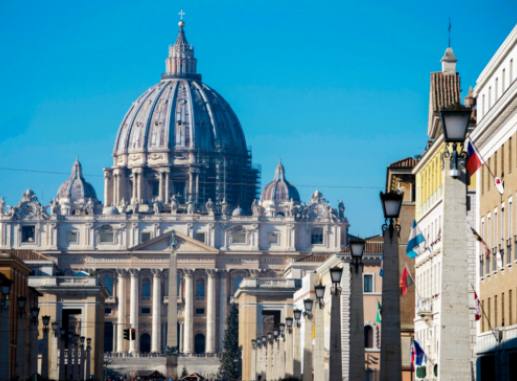St. Peter's Basilica, located in Vatican City, is one of the most renowned examples of Renaissance architecture in the world. One of the most striking features of this magnificent church is its intricate and elaborate mosaics, which adorn the walls and ceilings of the building. These mosaics not only showcase the skill and artistry of the craftsmen who created them, but also hold deep symbolic significance in the religious iconography of the Catholic Church. In this article, we will explore the techniques, materials, iconography, and symbolism of the mosaics at St. Peter's Basilica, as well as the ongoing restoration and preservation efforts to ensure that these beautiful works of art endure for generations to come.

Techniques and Materials Used in Creating the Mosaics at St. Peter's Basilica
One of the most remarkable features of St. Peter's Basilica is its stunning mosaics, which decorate the walls, ceilings, and domes of the church. These mosaics were created using a variety of techniques and materials that have stood the test of time.
The mosaics at St. Peter's Basilica are made primarily of glass tesserae, which are small pieces of colored glass that are carefully arranged to create intricate designs. These tesserae were hand-cut and polished to create a smooth surface before being laid onto the mosaics. In addition to glass, other materials such as marble, gold leaf, and precious stones were also used to add depth and detail to the mosaics.
The technique used to create the mosaics at St. Peter's Basilica is known as the traditional Roman mosaic technique, where the tesserae are set into a bed of lime mortar. The artists who created these mosaics were highly skilled and precise, as the tesserae had to be carefully arranged to create the desired patterns and images.
To ensure that the mosaics at St. Peter's Basilica remain vibrant and beautiful, restoration and preservation efforts have been ongoing for many years. These efforts involve cleaning, repairing, and conserving the mosaics to prevent damage and deterioration. By using modern techniques and materials, conservators are able to maintain the integrity and beauty of the mosaics for future generations to admire and appreciate.
Iconography and Symbolism in the Mosaics of St. Peter's Basilica
The mosaics of St. Peter's Basilica in Vatican City are rich in iconography and symbolism that convey important religious themes and messages. These intricate works of art are filled with religious imagery that holds deep significance for the Catholic faith. The use of symbols and figures in the mosaics serves to communicate the stories of the Bible and the teachings of the Catholic Church to the faithful who visit the basilica.
One of the most prominent symbols found in the mosaics of St. Peter's Basilica is the image of the keys, which are a reference to the keys to the Kingdom of Heaven that were given to St. Peter by Jesus in the Bible. This symbol represents the authority and leadership of the papacy, as St. Peter is considered the first pope of the Catholic Church. Another common image in the mosaics is the dove, which symbolizes the Holy Spirit and is often used to represent the presence of God.
Other symbols found in the mosaics of St. Peter's Basilica include the cross, which is a central symbol of Christianity, and the lamb, which represents Jesus as the sacrificial lamb of God. Additionally, various saints and biblical figures are depicted in the mosaics, each with their own symbolic meaning and significance within the Catholic tradition.
Overall, the iconography and symbolism in the mosaics of St. Peter's Basilica play an important role in conveying the religious beliefs and teachings of the Catholic Church. These intricate works of art serve as a visual representation of the faith and provide a deeper understanding of the spiritual significance of the basilica for visitors and worshippers alike.
Restoration and Preservation Efforts for the Mosaics in St. Peter's Basilica
Restoration and Preservation Efforts for the Mosaics in St. Peter's Basilica
The mosaics in St. Peter's Basilica are not only exquisite works of art, but also valuable historical and religious artifacts that require careful maintenance and preservation. Over the centuries, these mosaics have suffered damage from natural elements, air pollution, and even human activity. In order to ensure their longevity and protect their beauty for future generations, extensive restoration and preservation efforts have been undertaken.
Restoration of the mosaics in St. Peter's Basilica is a meticulous process that requires expert knowledge and skill. Conservators carefully clean the mosaics using delicate tools and techniques to remove dirt, grime, and other debris that have accumulated over time. They also repair any damaged or missing tiles, ensuring that the intricate designs of the mosaics are fully intact.
Preservation efforts for the mosaics in St. Peter's Basilica also include measures to protect them from further deterioration. This may involve installing protective coverings or barriers to shield the mosaics from direct sunlight, moisture, and other environmental factors that could cause harm. Additionally, ongoing monitoring and maintenance are essential to ensure that any potential issues are addressed promptly.
Thanks to the dedicated work of conservators and experts in the field, the mosaics in St. Peter's Basilica continue to be a stunning showcase of artistic and religious significance. Through careful restoration and preservation efforts, these intricate works of art are able to be enjoyed for generations to come.
